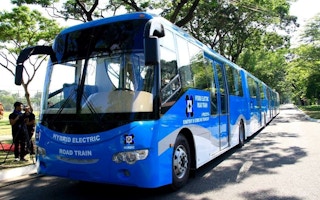At the Philippines’ Science and Technology Week held 24-28 July at the SMX Convention Center in Manila, the Department of Science and Technology (DOST) unveiled its Hybrid Electric Road Train (HERT) project.
The 40-metre long train-like buses will transport citizens on Metro Manila’s major arteries that currently are clogged with heavy traffic.
The five-coach, fully air-conditioned road train can accommodate up to 240 commuters per ride and has a maximum speed of 50 kilometres per hour. It is energy-efficient and eco-friendly, alternately running on hybrid diesel fuel and an electric battery. Additionally, it is cost-effective since most of its parts are locally sourced.
Talks are being held for the locally designed, engineered and manufactured HERT to be used to transport employees between various locations at the Clark Freeport Zone, where it had its soft launching last 25 June.
According to Rio Pagtalunan, chief of the analysis and testing division of DOST’s Metals Industry Research and Development Center, the train system is still the most efficient public mass transportation system in the country which is why the DOST is looking at developing an innovative transportation system out of the train system model.
Mario Montejo, science and technology secretary, estimates that the road train can serve 650,000 commuters when fully implemented after another two to three years in testing.
Having lived in Manila for several years now, I’ve tried to minimise my weekday commute as much as possible to escape the horrid local traffic. The new project seems to be a partial solution: it can transport large numbers of commuters and offers an alternative to the already overcrowded elevated light rail systems that also break down frequently.
However, since the road train will traverse Metro Manila’s streets, it may need its own dedicated lane to bypass traffic congestion. But this in turn may congest current streets even more. Running at slow speed and taking up much space due to its size, the HERT project appears to have an impractical side to it.
This article has been produced by SciDev.Net’s South-East Asia & Pacific desk.

















